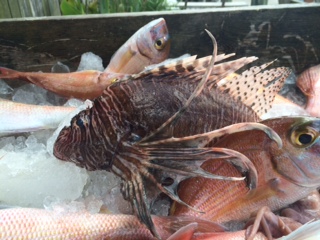
by Rick O'Connor | Feb 28, 2018

Lionfish caught on rod and reel. Photo Credit: Alison Rogers
Since the first lionfish was spotted off Pensacola in 2010, panhandle organizations have been busy trying to control the spread of this invasive species. The story is well known to many… the lionfish is a voracious predator, consuming at least 70 different species of small reef fish, including vermillion snapper. They reproduce frequently, producing an average of 25,000 eggs/female every four days – and they breed during most of the year. The densities of these fish on our nearshore and offshore reefs are some of the highest in the South Atlantic region, and they prefer artificial reefs to natural bottom. We know they have spread across the northern Gulf to include all five Gulf states and are found in Mexican waters.
We also know that the primary method of removal is still spearfishing. The state of Florida has an open season on them and provides a program to assist local divers with selling their harvest. There are several rodeo tournaments along the Gulf coast and some traditional fishing tournaments have created a category for them. Education programs about the problem continue and some restaurants have offered them when they can get them.
So how are things going?
Are we on top of controlling the lionfish?
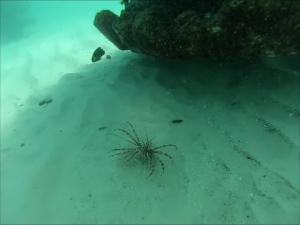
Lionfish at Pensacola Beach Snorkel Reef. Photo Credit: Robert Turpin
Anecdotal reports suggest we have made some impact. Local divers in the Pensacola area report that the shallower public reefs frequented by local divers and dive charters have indicated they are getting harder to find. There have been some tour trips, taking out of town residents diving for lionfish, where they have had to really search to find them. This is certainly encouraging and a numerical assessment of this is needed. However, there are also reports of charter fishing boats catching them on hook and line in deeper waters. They are not catching many, but they do occasionally grab them. When they do, it is usually on live bait and in deep water, 200 feet or so. Local divers seem to agree with this. They too find more lionfish, and some large ones, at depth – too deep to take a typical dive charter trip to remove.
Recent research has shown that lionfish are able, at least in the northern Gulf of Mexico, to swim greater distances than once thought to re-colonize reefs that have been cleaned. One study showed that selected artificial reefs, which were completely cleaned of lionfish, had restored lionfish populations, both young and old fish, within a year. This same study suggests that to keep lionfish at relatively low-density (about 5 lionfish/100 m 2) reefs would need to be cleaned every two months.
Several lionfish derbies occur along the Florida panhandle, but not at the frequency that may be needed to control re-colonization of shallower reefs by lionfish from deeper ones.
Can we increase the number of derbies?
Sure… but those who work on these derbies know the time and financial commitment required to put one on. It could happen that the number of local derbies would increase but we may have to think of other means of controlling lionfish.
One idea is to increase the number who harvest commercially. To do so a diver would need to acquire a saltwater products license from the Florida Fish and Wildlife Conservation Commission (FWC). On their website, they provide the application and a list of approved buyers for the diver to contact. http://www.myfwc.com/Lionfish.
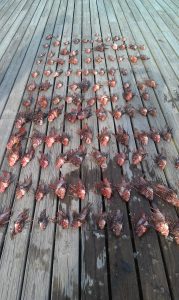
Harvested lionfish. Photo Credit: Bryan Clark
One drawback to the commercial idea is the price. Currently divers require a high price for their catch in order to cover cost and show a profit. These high prices equate to high prices at local restaurants, higher than the public may be willing to pay. One unpublished study shows that some locals are willing to pay more for a lionfish dinner if they know it is helping the environment. Many seafood lovers understand the high cost of lobster, but have not placed lionfish in the same category and are not as willing to pay higher prices; this may have to change. Research continues on developing a lionfish trap that has low by-catch rates. If an effective trap is developed, they could be deployed from vessels, which would not require diving, and could bring prices down.
There is evidence that populations of small reef fish have significantly declined since 2010. Whether this was due to the oil spill, the lionfish invasion, or a combination is still not certain. It is known that local reefs that are cleaned of lionfish are repopulated with both large and small lionfish. We have had some success with removing but we still have work to do.
Reference
Dahl, K.A., W.F. Patterson, R.A. Snyder. 2016. Experimental Assessment of Lionfish Removals to Mitigate Reef Community Shifts on Northern Gulf of Mexico Artificial Reefs. Marine Ecology Progress Series. Vol 558. Pp: 207-221.
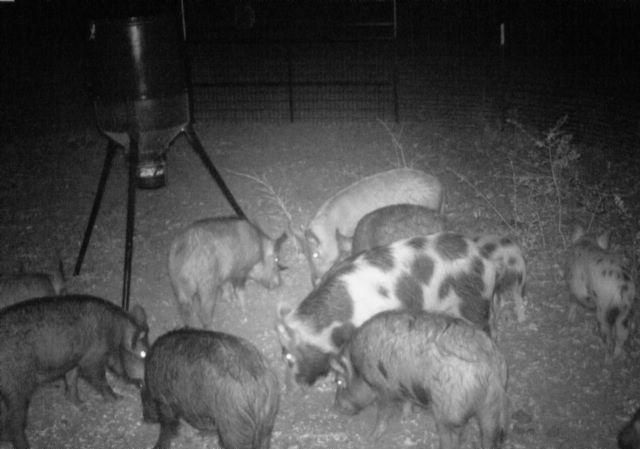
by Jennifer Bearden | Feb 28, 2018

Hog rooting damage in a pitcher plant bog. Photo Credit: Jennifer Bearden
Despite efforts by public and private land managers, feral hog populations continue to rise in many areas in Florida. Feral hogs damage crop fields, lawns, wetlands, and forests. They can negatively impact native species of plants and animals. Their rooting leads to erosion and decreased water quality.
There are several options for controlling feral hogs. Choosing the right option depends on the situation. Options include:
- Hunting with dogs,
- Hunting with guns,
- Box Traps,
- Corral Traps.
Let’s talk about these options.
Hunting with dogs is really not very effective for removing enough hogs to control populations. Dog hunting can move sounders of hogs from areas where damage is occurring for a period of time. This can be helpful when crops need to be protected from hog damage until they can be harvested.
Shooting hogs also is not effective for removing large numbers of hogs. Situations where it is successful include protecting crop fields and for taking hogs that will not go into a trap. Shooting success depends the education level of the hogs and the sophistication of the shooting equipment available. Hogs learn quickly to avoid danger. They learn by watching other hogs who get shot or trapped. Hunting pressure can disrupt hog patterns and make them harder to trap or hunt.
Box traps can be effective at trapping young hogs that are not trap smart. A study conducted by a graduate student, Brian Williams, at Auburn University looked at the efficacy of different trap styles. Young hogs entered box traps and corral traps at similar rates. The study also found that adult females were 120% more likely to enter corral traps than box traps and adult males were more reluctant to enter either trap style but were more likely to enter the corral traps. (Williams et al, 2011)
Corral traps are shown to be most effective for eliminating complete sounders. By eliminating a sounder at once, populations can be reduced. Corral traps are also more economical. In the Auburn study, the trapping cost per pig for box traps was $671.31 and for corral traps was $121.28.
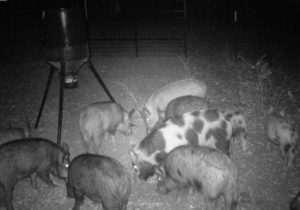
Sounder of hogs in a corral trap. Photo Credit: Jennifer Bearden
Corral traps are best for capturing whole sounders. Box traps can be effective for capturing young hogs. When trap smart adult females or males are in an area, shooting or hunting with dogs are options. Just remember that hunting pressure often just moves the hog problem onto another property. In order to eliminate hogs from a given area, we must employ several of these strategies. For example, we may be able to trap a sounder in a given area but still have a group of boars that will not go into a trap. In this case, we may set up to shoot them after trapping the rest of the hogs in a corral trap. By using these two techniques, we can drastically reduce the number of hogs in an area.
For more information about feral hogs, go to http://articles.extension.org/feral_hogs.
Reference: Brian L. Williams, Robert W. Holtfreter, Stephen S. Ditchkoff, James B. Grand Trap Style Influences Wild Pig Behavior and Trapping Success. Source: Journal of Wildlife Management, 75(2):432-436

by Jennifer Bearden | Feb 27, 2018
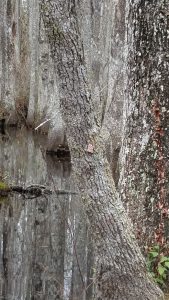
Wetland area on Hurlburt Field Air Force Base has been invaded by channeled apple snails. Photo Credit: Lorraine Ketzler
When you think of snails, you probably aren’t thinking about scary monsters that have been unleashed to terrorize us all. I’m here to warn you that you should. The channeled apple snail (Pomacea canaliculata) is a known agricultural pest that competes with native snail species. In our area (panhandle Florida, Hurlburt Field to be exact) this snail is consuming unknown quantities of plant material in our sensitive wetlands. If you didn’t know, Hurlburt Field Air Force Base is one of the last places on Earth where the endangered reticulated flatwoods salamander (Ambystoma bishopi) can still be found, and this endangered salamander relies on healthy wetlands and ephemeral ponds for breeding.
So why should you worry? Just think about how snails eat: snails have a tongue (a radula) with teeth-like structures (denticles) they use to rasp or drill into their food. Normally, nobody would really worry about what snails are eating; they’re snails, right? But, here comes the scary part: when there are many snails, all eating and breeding and growing and eating, they consume a lot of material. And, what once was a cute little snail in your 10-gallon aquarium becomes a rampaging menace when you dump your tank out in the ditch next to your house and the snail escapes into the wild!
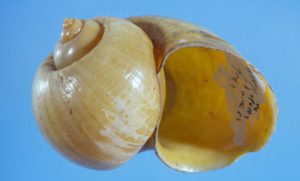
Channeled applesnail, Pomacea canaliculata (Lamarck, 1819). Photograph by Jeffrey Lotz, DPI. Click on the picture for more information on apple snails in Florida.
Ok, let’s be honest, it’s not like snails are running wild. I mean, they’re as slow as…well…snails. But what we believe began as a dumped aquarium pet some years ago has become a large population that is expanding into our wetlands. Although it is currently not found in our salamander breeding ponds (whew!), if we don’t do something to stop it, it soon could be. Here we are in Florida, where we have many examples of dumped or escaped animals that are breeding and growing and eating and breeding with no population control. This is one heck of a great example of an invasive species.
So, what are we going to do about this creeping, slimy, menace? Well, in our case, we called our invasive species contractor, and this year we will begin a labor-intensive project to control this species’ population on Hurlburt Field. We could use your support! Please use the IveGot1 app or EDDMaps to report local encounters with channeled apple snails. And, please DO NOT release non-native wildlife into the wild!
Guest Author:
Lorraine “Rain” Ketzler
Associate Wildlife Biologist
Hurlburt Field Natural Resources Manager
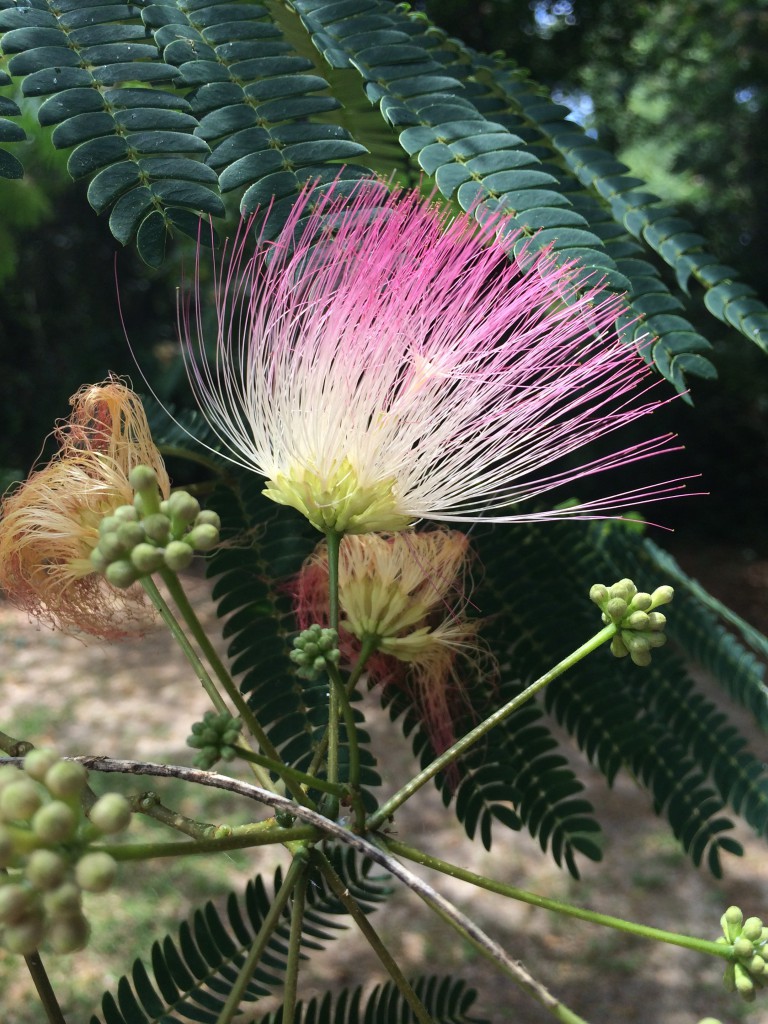
by Jennifer Bearden | Feb 27, 2018
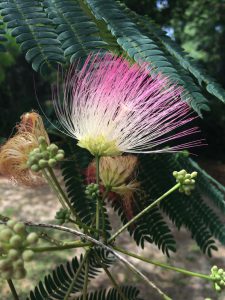
Fluffy Mimosa Bloom. Photo Credit: Mary Salinas
All along the roadsides and in home landscapes in summer, a profusion of fluffy pink blossoms are adorning trees known as mimosa, or Albizia julibrissin. This native of China was introduced to home landscapes in this country in the 1700’s to enjoy the fragrant, showy flowers and fine, lacy foliage. However, there is a dark side to this lovely tree. After blooming, it produces an abundance of pods each containing 5 to 10 seeds. Seeds can be spread by wildlife and water; this is evidenced by the appearance of mimosa trees along the roadways, streams and in our natural areas. The seeds can also remain dormant for many years, allowing the trees to keep sprouting long after the mother tree is gone.
Mimosa has been categorized as an invasive exotic plant in Florida by the University of Florida IFAS Assessment of Non-Native Plants in Florida’s Natural Areas. This designation means that the tree has not only naturalized, but is expanding on its own in Florida native plant communities. This expansion means that our native plants in natural areas get crowded out by mimosa as it reproduces so prolifically.
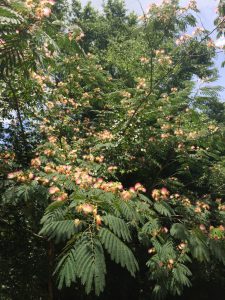
Mimosa tree in bloom. Photo Credit: Mary Salinas
The Florida Exotic Pest Plant Council (FLEPPC) publishes a list of non-native plants that have been determined to be invasive. Click here for the most recent 2017 list!
The first step in controlling this pest plant is to remove existing plants in the landscape. Cutting it down at soil level and immediately painting the stump with a 25% solution of glyphosate or triclopyr should do the trick. Further details and control methods can be found here.
There are some native trees that make excellent alternatives to mimosa such as fringe tree (Chionanthus virginicus), silverbell (Halesia carolina) and flowering dogwood (Cornus florida).
Guest Author:
Mary Salinas
Residential Horticulture Agent
Santa Rosa County
by Ray Bodrey | Oct 30, 2017
In the Panhandle, we are blessed to be surrounded by some of the most beautiful and ecologically diverse, fresh & marine water bodies on the planet. Paddle sports are the perfect way to experience. So, get out and explore!
The oldest form of paddle sports, canoeing, is a great way to explore our natural waterways. Canoeing is an ancient mode of transportation that dates to the late 19th century. This simple recreational activity involves a single-bladed paddle and the canoe. It’s best to have friend along for the canoe ride to share the adventure, and to make paddling a breeze. Fun fact, canoeing and kayaking became part of the Olympic Games in the summer of 1936.
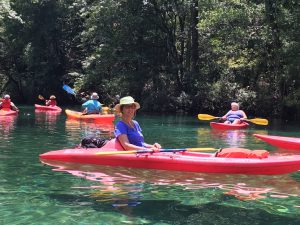
Photo: Kayaking on Econfina Creek.
Credit: Laura Tiu, UF/IFAS Okaloosa & Walton Counties.
Kayaking is a bit different than canoeing. In contrast, kayaks were first built thousands of years ago in the Artic. The first kayaks were built of driftwood and animal skin. Kayaks can be made of many different materials today, and inflatable crafts are gaining popularity. The sitting position of the paddler on a kayak is more centrally located than with the canoe, with legs in front and the paddler facing forward. This activity also requires a double-bladed paddle. Sizes and shapes will vary depending on the region and size of the paddler. Kayaking is great to couple with diving, snorkeling, or even fishing. Sites for these activities can often range for miles off the coastline or in remote river locations with no launching or wading point nearby. Not only is kayaking much cheaper than purchasing and maintaining a power boat, it’s an environmentally friendly and healthy way to navigate waters.
Paddleboarding is the new kid on the block. This is essentially stand up paddle surfing. Paddleboarders stand up right on boards and use a single-bladed paddle to thrust through the surf. This activity is usually performed on the open ocean. It’s especially fun in Florida bays. A paddleboard that is approximately 14’ in length is usually the recommended size for most settings. There are various types of boards that can be used, including surfboards. Most paddleboards are made of fiberglass.
As with any watercraft, a buoyancy aid or life jacket should be equipped on the person always. The participant should also have various other measures of safety gear. A whistle for signaling for help should be with all participants. For kayakers and canoers, rope is helpful to have when someone needs rescue. A diving knife and water shoes can be helpful when bottom terrain poses a threat. Proper clothing such as a rash guard or wet suit will help protect from the elements. Don’t forget your sunscreen any time of year!
For more information on paddle sports and ecotourism please contact your local county extension office.
UF/IFAS Extension is an Equal Opportunity Institution.
by Shep Eubanks | Sep 22, 2017
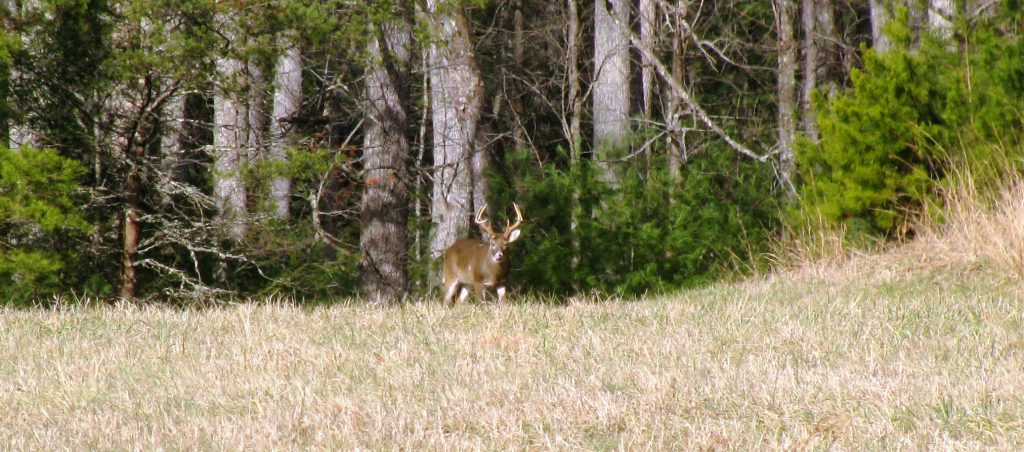
Big Buck on the Move – Photo Credit Shep Eubanks, UF/IFAS
About this time each year the minds of sportsman and wildlife aficionados turn towards the planting of wildlife food plots for use by wildlife in fall, winter , and early spring. There are many factors to consider when planting a fall food plot if you want to be successful in the endeavor. Food plots can be an effective method of providing food sources for game birds, deer, rabbits, raccoons, and other species. The size of food plots vary according to landowner preferences and the requirements of the target wildlife species, but usually they are a minimum of 1/2 to 1 acre in size, with a maximum of 5 acres.
Location is a an important consideration when planning the plot as the most effective plots typically are located adjacent to sanctuary or escape cover that provides security for wildlife. Food plots that meander along edges of of two or there converging types of cover, such as the edge created where pine plantations, hardwood bottoms, and agricultural fields intersect, are very attractive to wildlife and provide natural travel corridors, in addition to providing a high nutrition food source.
Successful planting of your crop begins with soil sampling. Having the proper pH in your food plot is of paramount importance. A pH of 6.5 is ideal for winter annual grasses and legumes in North Florida. As an Ag Agent I have seen more food plot disasters because a landowner did not take time to soil test than any other reason. The soil test will also guide you in applying proper fertilization to optimize productivity of your food plots. Food plots are expensive to establish and you want to avoid needless mistakes such as poor fertility that will yield poor results.
Preparation of a good seedbed is also very important as is selection of seeds that are adapted to our area. UF/IFAS has developed some excellent resources that will assist you in selecting forages that do well in our area such as, A Walk on the Wild Side: 2013 Cool-Season Forage Recommendations for Wildlife Food Plots in North Florida. Another Excellent reference is Establishing and Maintaining Wildlife Food Sources.
Now is the time to make your preparations for planting your successful cool season food plot here in North Florida! hopefully you will have the experience of seeing and enjoying wildlife as pictured in photo 2 and photo 3!
For more information on planting successful food plots this fall, contact your local UF/IFAS Extension office.
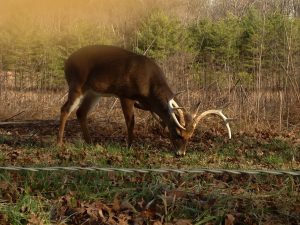
Photo 2. Nice Buck grazing woods edge food plot in North Florida Photo Credit – Shep Eubanks, UF/IFAS
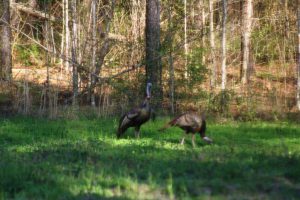
Photo 3. Gobbler and Hen Standing in Crimson Clover
Photo Credit – Shep Eubanks, UF/IFAS

















